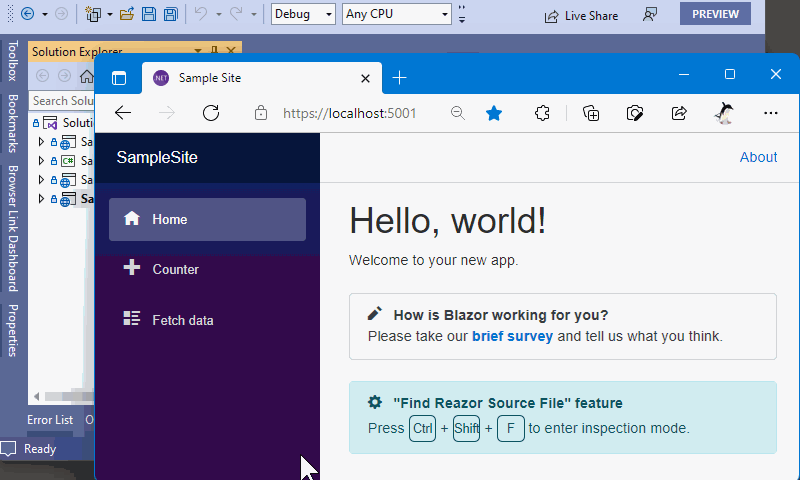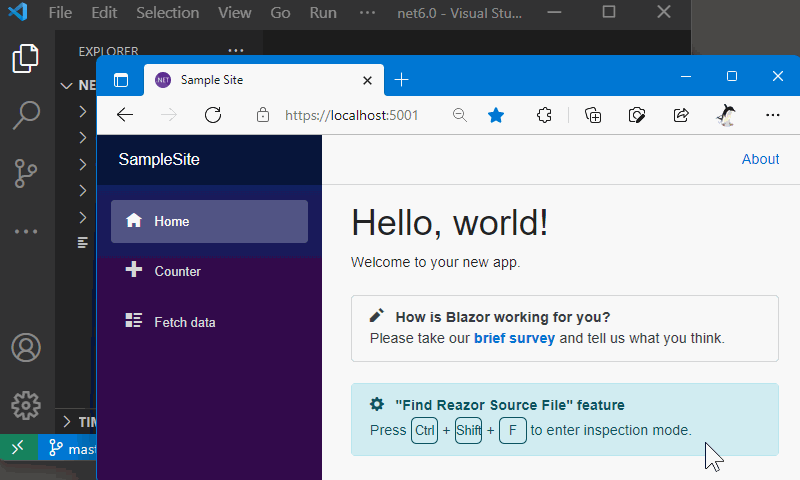FindRazorSourceFile.Server
1.0.0-preview.14.0
dotnet add package FindRazorSourceFile.Server --version 1.0.0-preview.14.0
NuGet\Install-Package FindRazorSourceFile.Server -Version 1.0.0-preview.14.0
<PackageReference Include="FindRazorSourceFile.Server" Version="1.0.0-preview.14.0" />
<PackageVersion Include="FindRazorSourceFile.Server" Version="1.0.0-preview.14.0" />
<PackageReference Include="FindRazorSourceFile.Server" />
paket add FindRazorSourceFile.Server --version 1.0.0-preview.14.0
#r "nuget: FindRazorSourceFile.Server, 1.0.0-preview.14.0"
#addin nuget:?package=FindRazorSourceFile.Server&version=1.0.0-preview.14.0&prerelease
#tool nuget:?package=FindRazorSourceFile.Server&version=1.0.0-preview.14.0&prerelease
FindRazorSourceFile
What's this?
This package makes your Blazor apps display the source .razor file name that generated the HTML element under the mouse cursor when entering the Ctrl + Shift + F hotkeys.


For a quick visual overview, watch Jimmy Engström’s introduction video:
1. Installation
1-a. For Blazor WebAssembly projects
- Add the
FindRazorSourceFile.WebAssemblyNuGet package to your Blazor WebAssembly project.
> dotnet add package FindRazorSourceFile.WebAssembly
- Add calling of the
UseFindRazorSourceFile()extension method forWebAssemblyHostBuilderat the startup of your Blazor WebAssembly app.
// This is a "Program.cs" file of a Blazor Wasm app.
...
using FindRazorSourceFile.WebAssembly; // 👈 Open this namespace, and...
...
var builder = WebAssemblyHostBuilder.CreateDefault(args);
builder.UseFindRazorSourceFile(); // 👈 Add this line.
...
The UseFindRazorSourceFile() method will work only when the target configuration is not "Release". That means any resources from "FindRazorSourceFile" will not be loaded in the app after it is published with trimming. So, you don't need to worry about increasing the app size due to linking this library in the release environment. If you need to suppress the loading resources of this library in other configurations, please set the EnableFindRazorSourceFile property to false in the project file. For example, <EnableFindRazorSourceFile>false</EnableFindRazorSourceFile>.
1-b. For Blazor Server projects
- Add the
FindRazorSourceFile.ServerNuGet package to your Blazor Server project.
> dotnet add package FindRazorSourceFile.Server
- Add calling of the
UseFindRazorSourceFile()extension method forIApplicationBuilderat the startup of your Blazor Server app.
// This is a "Program.cs" file of a Blazor Server app.
...
using FindRazorSourceFile.Server; // 👈 Open this namespace, and...
...
var builder = WebApplication.CreateBuilder(args);
...
var app = builder.Build();
if (app.Environment.IsDevelopment())
{
...
app.UseFindRazorSourceFile(); // 👈 Add this line.
}
...
1-c. For Blazor components library projects (Razor Class Library)
If your solution contains a Razor Class Library (RCL) project and you want to enable "find razor source file" for its components, add the FindRazorSourceFile NuGet package to the RCL project as well.
> dotnet add package FindRazorSourceFile
This ensures that CSS scope IDs are generated for all .razor files in the RCL, which is required for the detection feature to work.
1-d. For Blazor Web Application projects created with .NET 8 or later (new project template)
If you created your Blazor app using the .NET 8 or later "Blazor Web App" project template, please follow these steps:
Server-side project:
Add theFindRazorSourceFile.ServerNuGet package and configureUseFindRazorSourceFile()in your server project'sProgram.csas described above.Client-side project (if present):
If your project uses Interactive Render Mode with "WebAssembly" or "Auto", you will also have a client project.
In this case, add theFindRazorSourceFile.WebAssemblyNuGet package and configureUseFindRazorSourceFile()in the client project'sProgram.csas described above.Razor Class Library (if present):
If your solution includes a Razor Class Library, add theFindRazorSourceFileNuGet package to the RCL project as described above.
Summary Table
Project Type Required Package(s) Required Setup in Program.cs Server (host) project FindRazorSourceFile.Server UseFindRazorSourceFile() Client (WASM/Auto) project FindRazorSourceFile.WebAssembly UseFindRazorSourceFile() Razor Class Library (RCL) FindRazorSourceFile (no code, just add package)
2. Usage
2-1. Entering the "Inspection Mode"
After installing FindReSource in your Blazor project, the Blazor app running in a web browser will respond to Ctrl + Shift + F keyboard shortcuts entering to "Inspection Mode".
When the app entered "Inspection Mode," the entire browser screen will dim.
In this state, when you moved the mouse cursor, the HTML element under the mouse cursor will be highlighted, and the tooltip that displayed the source .razor file name generated that HTML element will appear.
2-2. Entering the "Lock Mode"
When you click an HTML element during the "Inspection Mode", the application's state will enter the "Lock Mode".
During the "Lock Mode", hovering the mouse cursor over the other HTML elements will have no effects.
The highlighting of the HTML element and showing the tooltip will be maintained.
This mode will be helpful for you to selecting and copy to the clipboard the source .razor file name displayed on the tooltip.
2-3. Exit each mode
To escape from these modes, you can press the ESC key.
And also, the mouse click during the "Lock Mode" will exit that mode and return to "Inspection Mode".
3. Open in Visual Studio Code
Once you enable the "Open the .razor file of the clicked component in VSCode" option from the "Find Razor Source File" settings button, which is placed in the bottom-right corner of the page,

the .razor file of you clicked component will be opened in a Visual Studio Code editor.
4. Open in Visual Studio IDE - the Visual Studio Extension for "FindRazorSourceFile"
If you are using Visual Studio IDE on Windows OS, please check out the Visual Studio Extension "Find Razor Source File - Browser Link Extension / VS2022 Extension" from the URL below.
- for Visual Studio 2019 - https://marketplace.visualstudio.com/items?itemName=jsakamoto.findrazorsource-browserlink-vsix
- for Visual Studio 2022 - https://marketplace.visualstudio.com/items?itemName=jsakamoto.findrazorsource-browserlink-vsix-2022
If you have installed the extension above in your Visual Studio IDE and configured everything required to enable the "BrowserLink" feature of Visual Studio, entering "Lock Mode" causes opening the .razor file the source of clicked HTML element automatically in your Visual Studio!
3-1. Requirements
- Visual Studio 2019 or 2022
3-2. Usage
To enable "Find Razor Source File - Browser Link Extension / VS2022 Extension", please follow the instruction below.
Of course, the target project must have installed the "FindRazorSourceFile" feature, and please confirm the "Inspection Mode" and "Lock Mode" works well on a web browser before.
Check on the "Enable Browser Link" dropdown menu in the toolbar of your Visual Studio.

If you are using Visual Studio 2019, you have to do an additional instruction below.
<details> <summary>Additional instruction steps in VS2019</summary>
- Add the
Microsoft.VisualStudio.Web.BrowserLinkNuGet package to your Blazor Server or ASP.NET Core host project.
> dotnet add package Microsoft.VisualStudio.Web.BrowserLink
- Add calling of the
UseBrowserLink()extension method forIApplicationBuilderat the startup of your Blazor Server app or ASP.NET Core host app.
// This is a "Startup.cs" file of a Server app.
...
public void Configure(IApplicationBuilder app, ...)
{
if (env.IsDevelopment())
{
...
app.UseBrowserLink(); // 👈 Add this line.
...
}
...
IMPORTANT NOTICE: Please place the calling UseBrowserLink() before the calling UseFindRazorSourceFile() if the project is a Blazor Server.
</details>
After doing the all steps of the instruction above and launch the project, the .razor source file will be opened in the Visual Studio when the HTML element is clicked in the "Inspection Mode" on a web browser! 👍
5. Limitations
FindRazorSourceFile identifies the original .razor file that generated a DOM element by relying on Blazor's "Isolated CSS" mechanism. Specifically, it traces back to the source file using the automatically injected CSS scope IDs (e.g., b-xxxxx) assigned to HTML elements during rendering.
Due to this reliance on CSS scope IDs, there are several limitations:
- Components Without Direct HTML Elements: If a
.razorfile contains only child components (and no direct HTML elements), then no CSS scope ID is injected for that file. As a result, FindRazorSourceFile cannot detect such components in the rendered DOM. - Ambiguous boundaries in complex components: If a component contains multiple root-level HTML elements, the tool may misidentify component boundaries or highlight unexpected regions in the DOM.
These behaviors are inherent to the current implementation, which depends exclusively on CSS scope IDs to determine the source of rendered DOM elements.
To overcome these limitations, you can use the explicit component detection mechanism described in the next section.
6. Improved Component Detection with FRSF_BEGIN_COMPONENT / FRSF_END_COMPONENT
To overcome the limitations described above, FindRazorSourceFile provides a mechanism for explicit component boundary marking using static methods: FRSF_BEGIN_COMPONENT and FRSF_END_COMPONENT. By manually adding these markers to your .razor files, you can significantly improve the accuracy of component detection, even for components without direct HTML elements or with multiple root-level elements.
How to Use
- Import the static methods
In your project's_Imports.razor, add the following line:
@using static FindRazorSourceFile.FindRazorSourceFileMarker
- Add markers to your component
At the beginning and end of your.razorfile, insert calls to those static methods:
@FRSF_BEGIN_COMPONENT() @* 👈 Add this line, and... *@
@page "/"
<h1>Hello, world!</h1>
<p>Welcome to your new app.</p>
@FRSF_END_COMPONENT() @* 👈 add this line. *@
This will cause FindRazorSourceFile to inject special comment markers into the rendered DOM, allowing it to accurately associate DOM regions with the correct .razor file.
Notes on Debug and Release Builds
Debug builds: When building in Debug configuration, the full path of the
.razorfile is embedded in the assembly and included in the marker comments. Be aware of potential security implications if you deploy Debug builds.Release builds: In Release configuration, no
.razorfile paths are embedded, and the marker comments are not emitted. This ensures there is no impact on performance or assembly size in production.
By using these explicit markers, you can resolve the detection limitations and achieve precise mapping between DOM elements and their source .razor files.
License
| Product | Versions Compatible and additional computed target framework versions. |
|---|---|
| .NET | net8.0 is compatible. net8.0-android was computed. net8.0-browser was computed. net8.0-ios was computed. net8.0-maccatalyst was computed. net8.0-macos was computed. net8.0-tvos was computed. net8.0-windows was computed. net9.0 is compatible. net9.0-android was computed. net9.0-browser was computed. net9.0-ios was computed. net9.0-maccatalyst was computed. net9.0-macos was computed. net9.0-tvos was computed. net9.0-windows was computed. net10.0 was computed. net10.0-android was computed. net10.0-browser was computed. net10.0-ios was computed. net10.0-maccatalyst was computed. net10.0-macos was computed. net10.0-tvos was computed. net10.0-windows was computed. |
-
net8.0
- AngleSharp (>= 0.14.0)
- FindRazorSourceFile (>= 1.0.0-preview.14.0)
-
net9.0
- AngleSharp (>= 0.14.0)
- FindRazorSourceFile (>= 1.0.0-preview.14.0)
NuGet packages
This package is not used by any NuGet packages.
GitHub repositories
This package is not used by any popular GitHub repositories.
| Version | Downloads | Last updated |
|---|---|---|
| 1.0.0-preview.14.0 | 93 | 6/3/2025 |
| 1.0.0-preview.13.0 | 176 | 5/11/2025 |
| 1.0.0-preview.12.0 | 144 | 4/21/2025 |
| 1.0.0-preview.11.0 | 125 | 4/20/2025 |
| 1.0.0-preview.10.0 | 151 | 4/17/2025 |
| 1.0.0-preview.9.0 | 157 | 4/15/2025 |
| 1.0.0-preview.8.0 | 154 | 4/15/2025 |
| 1.0.0-preview.7.0 | 61 | 4/12/2025 |
| 1.0.0-preview.6.0 | 99 | 3/27/2025 |
| 1.0.0-preview.5.0 | 7,498 | 1/9/2022 |
| 1.0.0-preview.4.0 | 184 | 1/4/2022 |
| 1.0.0-preview.3.0 | 1,341 | 9/2/2021 |
| 1.0.0-preview.2.0 | 185 | 8/31/2021 |
| 1.0.0-preview.1.6 | 2,824 | 8/3/2021 |
v.1.0.0-preview.14.0
- Fix: Fixed a build failure with the error message "File length for <path> is not defined" when using .NET SDK 9.0.300.
To see all the change logs, please visit the following URL.
- https://github.com/jsakamoto/FindRazorSourceFile/blob/master/FindRazorSourceFile.Server/RELEASE-NOTES.txt


